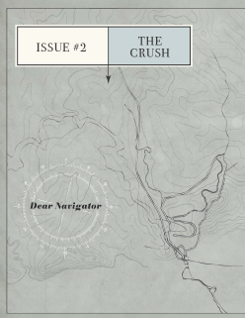You put yourself on something unseen.
Then, you are unable to take a look at something because you are not in the world.
Lessons from the Breakdown Lane
While attempting to upgrade to a new Ubuntu distribution Sunday late night, I managed to slag nickm.com. I don’t mean that I insulted my server; rather, I irrevocably converted it into a molten heap, or at least the software equivalent.
The bright side of such failures (perhaps the light is provided by the glowing and otherwise useless material that used to be serving my website) is that one learns how good one’s been at backing up. In my case, I actually had recent copies of almost all of my data stashed away: not only important files, but also the mysql database. That means that after about 12 hours of reinstalling and once more setting up my server, most of it was up and running.
The one thing I didn’t have, due to a permissions/backup quirk, was the image directory for this blog. I had a very old copy of the directory, but had stopped storing local copies of blog images a while back, trusting in my backups that didn’t work. Obviously, I’m to blame; of more general interest than my culpability is what I tried in an attempt to find the missing images, and what did and didn’t work:
FAIL: The Internet Archive Wayback Machine. As best as I can tell, the Wayback Machine’s acquisition apparatus has been switched off since mid-2008. Nothing of Post Position is available at the Internet Archive – no trace of it. There’s no record of Grand Text Auto since mid-2008, either. I found only the tiniest hint of activity in recent months. The major, bustling site Reddit has exactly one image available for all of 2010. The IA Wayback Machine was better than nothing, but was never searchable; now it seems to be over.
SEMI-FAIL: Google. Google’s cache had/has a very small number of my images – only the ones I have recently posted. Perhaps Google cached my images from three months ago and longer in the past, too, but has removed them? The cache is nowhere near a snapshot of the Web, in any case. Google also keeps smaller copies of my images within its image search. All images there are degraded by being reduced in size and converted to jpg, even the smallest of images. This at least allows people in my situation to see what they’ve lost, though. Of course, Google’s cache is not meant as a serious archival tool, so recovering at least few recent files from there was nice.
FAIL: Bing. Yes, I checked the Bing cache (used by Yahoo) also. It doesn’t seem to cache images at all.
WIN: The Electronic Literature Organization and Archive-It.org. After I had more or less given up, and after I had started to recreate images to fill the gaps in blog posts, I remembered that Archive-It, thanks to the work of the Electronic Literature Organization, has archived not only works of electronic literature but also contextual information, such as e-lit authors’ websites. Their archives are searchable, too. Archive-It and the ELO did keep copies of material from nickm.com, and succeeded in preserving the images that I’d lost, outdoing the Internet Archive as well as Google, and Microsoft. (Again, I did get some copies of recent images from Google, and neither that cache nor Bing’s is intended as an archive.) Scott Rettberg did a great deal of work on the ELO Archive-It project, I know, which was undertaken by the ELO when Joe Tabbi was president. Matt Kirschenbaum worked to connect the ELO with Archive-IT, and Patricia Tomaszek did much of the implementation work. A particular thanks to those ELO folks along with the others who worked on this project.
Online archives don’t exist as backup services, of course, but it’s not absurd to see if they can help individuals and organizations in times of crisis – in addition to performing their main function of serving scholars and helping preserve our cultural memory. Given the intricacies of backing up, data storage and formats, and technological change to new systems and platforms, this is sure to be an important secondary function for the digital archive.
Please let me know if you find anything missing or broken here at nickm.com.
Announcing Sea and Spar Between
Just published in Dear Navigator 1:2/3 is a new poetry generator, Sea and Spar Between, by Nick Montfort and Stephanie Strickland.
This has been a major project of mine and Stephanie’s over the past year. We started seriously working on this project on December 15, 2009, when we met for the first of a few days in New York to discuss and start developing it. I thought it might take only a few days to complete – not a completely outrageous idea, since I have been working on tiny poetry generators such as “The Two” those in the ppg256 series, which were not time-consuming to produce. As you might guess, since it was just published today (on December 16, 2010), I was wrong about the time it would take. But, I am delighted that the project is appearing now in wonderful company in Dear Navigator, a beautiful and appropriately-named journal.
If memory serves, Stephanie and I met at Digital Arts and Culture ’99 in Atlanta. I remember the conversation we had about innovative literature soon afterwards at Limbo, a long-gone coffeehouse on Avenue A in New York. Stephanie offered her advice as I was putting together my application to the Boston University poetry program – one way in which she’s long been a mentor as well as a friend. We’ve served the Electronic Literature Organization together; I had the chance to collaborate with her in editing the Electronic Literature Collection, volume 1; and I’ve gotten to read with her and present in the same session at conferences many times over the years. Sea and Spar Between, though, is our first collaboration as poets.
We have a short statement about the project on the “How to Read Sea and Spar Between“ page; the text also appears on the page of Dear Navigator that introduces and links to the piece. I won’t quote from that page here, but I’ll mention that the generator produces a navigable space of stanzas and draws on the vocabulary of and our readings of Dickinson and Melville.
A few words about our collaboration on Sea and Spar Between: I sketched in code as the two of us worked together; we looked at and ran many intermediate versions as we figured out how we wanted to generate lines. I wrote the early versions of the stanza generator in Python, because I find that a better language to think and sketch in than JavaScript. Although I was the one who did the programming, Stephanie and I worked closely on all aspects of the project together: The strings that serve as data, the way lines are assembled, the way stanzas are assembled, the overall interface, and beyond. She and I were even working together to properly comment the code as the new issue of Dear Navigator was preparing for launch.
Speaking of that code, as you can see for yourself in the file seaspar.js, Sea and Spar Between is licensed under a free software license. As the license says, anyone may copy it, modify it, or make use of it in some other way in creating another project. I hope the project proves pleasing to interact with and read from on the Web and pleasing for those who wish to turn to the code.
Book Arts and Broadsides Showcased
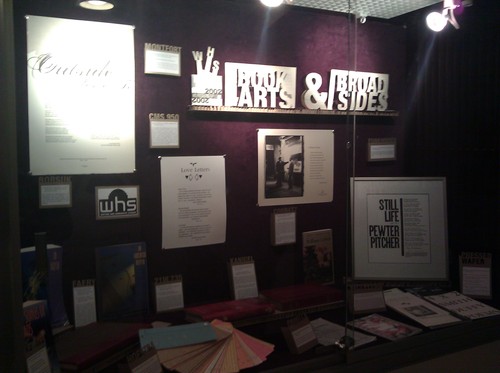
MIT’s Building 14 has a great new display thanks to poet Amaranth Borsuk, who is a Mellon postdoctoral fellow in the Writing & Humanistic Studies program, where I also work. There are some wonderful pieces from many of my colleagues and their students, all of them displayed brilliantly. I’ll mention the digital tie-ins: The broadside “Love Letters,” done in one of my graduate CMS.950 Workshop classes, consists of computer-generated poems produced by a Manchester Mark I emulator. These were set on a letterpress by the class thanks to the Bow & Arrow Press’s John Pyper. And Peer Hofstra, who took my 21W.750 Experimental Writing class last semester, did an extraordinary untitled book for his final project. It’s made of punched cards, with the words are formed by alphabetically-arranged letters punched out from those pages. Each word is some are subsequence of the alphabet, so “APT” can occur, while “APE” cannot. Alex Corella’s Experimental Writing final project, which cuts up and rearranges the text on Cambridge historical plaques, is also on display. If you’re on campus, do stop by to see the case, which is by the elevator on the first floor of Building 14. It will be up for at least this month, December 2010.
Actions in Curveship
I’ve been working the past few days to change the way actions are represented in Curveship. The previous model for actions is described well in sections 5.1.3 and 5.1.4 of my dissertation. I won’t go into it in any detail here, but it involved two sorts of abstractions (one higher-level and associated with intention and narrating, the other lower-level and used directly in the simulation) and was considerably more complex than what I have in the current system.
I will mention something about why actions are represented in the system at all – that is, with first-order representations, objects. This is a departure from the way IF systems have worked up to now. In other IF systems, when you “get lamp,” you change the state of the world. The lamp object has a different parent when you are done with this action. But there is no object representing the action itself, the adventurer getting the lamp. As you can tell from playing IF, this works fine if you want to stick to one character and narrate what is happening exactly once, as it happens.
Having a representation of action, on the other hand, allows for much more flexibility in narrating. One can narrate an action in flashback (because it’s still there, represented as an object) and can easily maintain lists of actions for each character, to represent what each specific character is aware of. In Curveship, these are kept in “concepts” which are theories about the world that are almost always incomplete and can even be wrong. Since all actions are reversible, the representation of actions also provides an infinite “undo” capability.
So, the action representation now simply provides actions of four types:
- Behave – Any action that doesn’t change the world, from speaking to jumping up and down.
- Configure – An action that causes an item to be moved to a new place, or to be in a new relation, in the item tree. (“get lamp” is an example.)
- Modify – An action that causes an item to change state, to have one of its features take on a new value. (“light lamp” is an example.)
- Sense – A perception of the world which does not change the world but may update a character’s concept.
For instance, this is the code that maps the command “get lamp” (or “get” followed by anything) into a particular “take” action, which is a configure action:
def take(agent, tokens, concept):
return Configure('take', agent,
template='[agent/s] [pick/v] [direct/o] up',
direct=tokens[1], new=('of', agent))
“take” is the verb and agent the agent; all Actions must have these two. The template is optional. It specifies the string-with-slots that is to be used in representing this action. All configure actions have a direct object, the item being configured, and need at least a “new” keyword specifying the link and parent that item will be in. Here, it’s “of” (indicating possession) and the agent (the one who is doing the taking.)
Curveship Analysis at Tufts

I just wanted to thank Norman Ramsey, Eddie Aftandilian, and Brad Larsen for the very productive day-long discussion of Curveship that we undertook on Friday. I’ve spent most of the weekend and much of today implementing just one of the ideas for changes that came out of this. The discussion certainly gives me more to do, but it also does a great amount to focus my efforts as I work toward a release of system.
Robot Prints and Binds Riddle & Bind
If you’re looking for my new book of poems, Riddle & Bind, and you happen to be near the MBTA’s Red Line or Harvard Square specifically, prepare for excitement. You can not only purchase the book in this venerable area of Cambridge; you can have the Harvard Book Store’s book-making robot, Paige M. Gutenborg, manufacture a copy of Riddle & Bind for you in about four minutes. The cost for the book and the bibliotronic display in which it is forged is simply the retail price, $16.
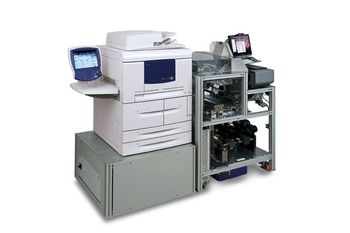 I have the feeling that someone must have put in a good word for me.
I have the feeling that someone must have put in a good word for me.
Update: As of August 14, 2012, Riddle & Bind is not available to be printed on the Espresso Book Machine at the Harvard Book Store. The book can be special ordered through the Harvard Book Store, however.
The MIT Press bookstore, down the red line at the MIT/Kendall stop, has copies of Riddle & Bind in the store and available for purchase.
This APC, For One, Welcomes…

I was startled to discover these two things at the post office today, the immediate implications of this message:
- The US Postal Service has developed a kiosk/robot capable of experiencing pleasure.
- Said robot is stimulated pleasurably by selling me a stamp.
I wanted to somehow let the robot know that I also appreciated the necessary service it performed. I thought about getting one of these Priority Mail stickers, writing on it “It was a pleasure, also, to be served by you, robot!,” and then slapping it on the side of the Automatic Postal Center. But the robot wouldn’t be able to read that message, would it? Maybe I could hold up a note with a similar message to the camera that is used to surveil patrons of the APC. But then I’d have to wait in line again, and I doubt the robot is capable of handwritten character recognition – it wouldn’t have asked me to type in the zip code if it was.
I can only hope that this faithful servant is among the many robot readers of my blog.
Also, I feed certain there must be some applications outside of the mail system for pleasure-experiencing robots, although none come to mind right away. Any ideas?
(Obligatory self-reference: An Automated Postal Center appears in my 2005 interactive fiction Book and Volume.)
Book Fest Podcasts
Audio podcasts of the events at the Boston Book Festival are now online – along with some videos. Whether you were one of the 25,000 attendees or not, you can catch some of the 2010 festival via the Web. The panel that I was on, “The Novel: A Prognosis,” can be heard right here.
Colloquium Past, Conference to Come in Mexico
I’ve recently returned from a great trip to Mexico City. I was at the 5th Mexican International Colloquium on Computational Creativity presenting alongside two other foreign guests, Graeme Ritchie and Dan Ventura, and two local researchers, Rafael Pérez y Pérez and Eduardo Peñaloza. There was a productive and lively roundtable on interdisciplinary work and collaboration the day before the talk, too. Rafael Pérez y Pérez, a collaborator of mine, arranged the colloquium and was a very gracious host, making sure that we got to and from the airport, to all of the colloquium events, and to several excellent meals.
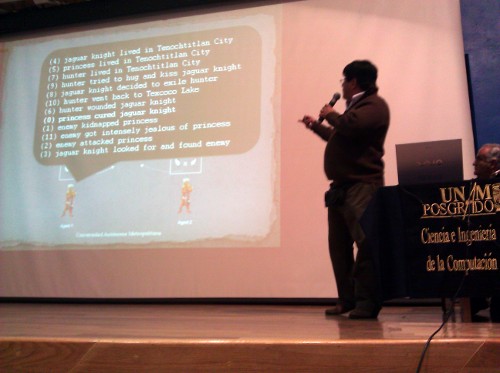
I have a few things to mention about the 5th MICCC, but I’d like for this post to be mainly forward-looking rather than backward-looking. That’s because ICCC-11, the 2011 International Conference on Computational Creativity, is an event on the same topic as this recent colloquium, and it will be taking place in the same city thanks to the local organizing work of our wonderful host, Rafael. Although the colloquium was intellectually rich and I enjoyed visiting Mexico City for its own sake, I was also very pleased because I was anticipating this larger-scale academic gathering that will be taking place April 27-29. In part, I was reminded of the conference because I and the other organizers, Rafael, Graeme, and Dan, spent a good bit of the time working to make the remaining decisions and to prepare for ICCC-11. But even just walking around the city, I had in mind how much other computational creativity researchers would enjoy coming to México.
At the colloquium, I was the only one who didn’t discuss a large-scale system that is somehow related to the creative process. (I do have a such a system, Curveship, but I wanted to focus on something else in this talk.) I spoke about creative computing and the relationship that this area has to computational creativity. In creative computing, the computer is seen as a medium and platform for human creative work. There’s a strong relationship between this area and computational creativity, but there are some distinctions, too. I spoke about a very short, simple Commodore 64 BASIC program:
10 PRINT CHR$(205.5+RND(1)); : GOTO 10
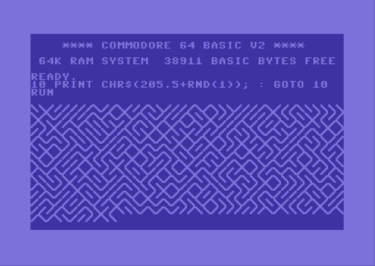
This one-line program is the focus of a deep investigation that I am undertaking with nine other authors. We plan for this study to result in a single-voice academic book – not an edited collection, not a “chapter book” with separately authored segments, but something that reads like a single-author book but is written by ten people. We are still in the early stages of writing this book, but it’s our hope that 10 PRINT CHR$(205.5+RND(1)); : GOTO 10 by Nick Montfort, Patsy Baudoin, John Bell, Ian Bogost, Jeremy Douglass, Mark Marino, Michael Mateas, C. E. B. Reas, Mark Sample, and Noah Vawter will be published by the MIT Press in 2012. (Yes, the book’s title is the program itself.) Since the colloquium focused on interdisciplinary work and collaboration, this seemed like a nice project to discuss, even though the ten of us working on this project are not trying to model the creative process using computation. I described how the study of this program shed additional light on the relationship between platform and creativity, and how it suggested that computational creativity models try to take into account that relationship.
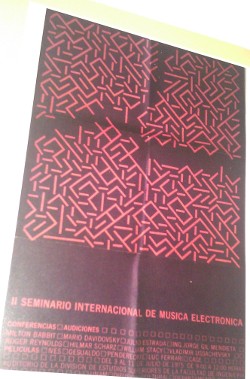
The other talks offered some excellent descriptions of and discussions of computational creativity systems: MEXICA, DARCI, and STANDUP (along with its predecessor, JAPE). These systems, and the things that have been done with them, are all great examples of creative computing, by the way, in addition to being computational investigations of creativity! I could do a post this long covering just the new thoughts that have come to me about these projects, each of which I knew about before. For now, I’ll refer you to the abstracts and links for more on those projects.
Coming up: The 2011 International Conference on Computational Creativity, April 27-29 in Mexico City
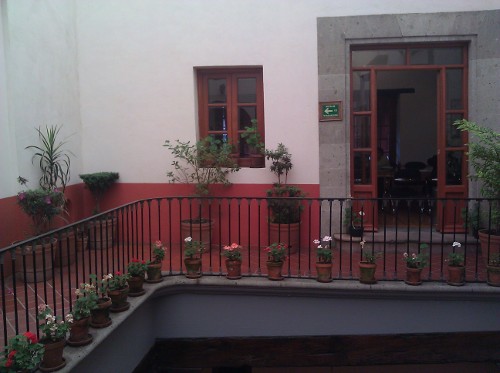
I’ve been to Mexico City before, but this was my first trip to the city’s main square, the Zócalo. This is the area where ICCC-11 will take place. It’s an amazing sight. You can see that Mexico City is mind-bogglingly big as you fly in, but the Zócalo is massive in a different way. The plaza and the area is human-scale (designed for pedestrians and very walkable, with many shops and restaurants) while also being tremendous and impressive. On the north is the cathedral; the National Palace, where President Calderón works, is to the east. An enormous Mexican flag flies from the National Palace during the day. To the west are several buildings, including the Best Western Majestic Hotel, which will be offering a discounted rate for ICCC-11. Just off the plaza, between the Cathedral and the National Palace, is where ICCC-11 will be held – at La Casa de la Primera Imprenta. The first printing press in the Americas was installed in 1536 in this building. It now offers a conference facility of just the right size for ICCC-11 presentations and demos, several galleries, and a bookstore.
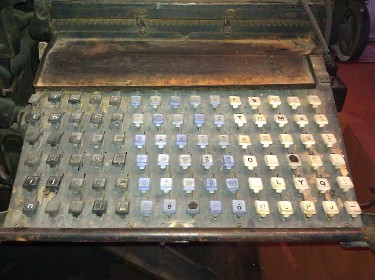
The Autonomous Metropolitan University, Cuajimalpa is the host institution for ICCC-11, which is also supported by UNAM’s postgraduate program in computer science and engineering. The colloquium that UAM-Cuajimalpa put on with UNAM was well-attended by students and faculty who had some good questions for us. I know that we will have great local arrangements for ICCC-11; the participation we had in the colloquium suggests that we will be part of some good conversations (and, no doubt, see some good presentations and demos) from local ICCC-11 attendees.
So, I hope to see you readers who work in computational creativity in Mexico City at the end of April. I’m the publicity chair for ICCC-11, but in addition to publicizing the conference, I’m glad to email with anyone who has questions about the conference or about visiting Mexico City. And, remember that the deadline for submissions (of short papers, long papers, or show-and-tell proposals) is December 13, less than a month away now: The call for papers has the details, and there is more information on other parts of the ICCC-11 site.
1 Days without Injury in Keyhole Factory
My collaborator and publisher William Gillespie has a new book, Keyhole Factory, and has done a vigorous interview about it which I suggest you read.
Festive Coders Make Curveship Codefest a Success
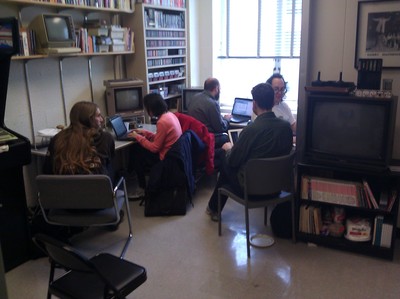
The Curveship Codefest today was all I hoped it would be – a source of ideas, a way to discuss how to progress toward release, and even a time for the development of several fiction files (games) and spin files (specifications for narrating), some profound, some amusing, some both. I have received some very useful patches, representing the first contributions to the core Curveship code from others since I started this project in 2006. It looks like – with some serious work on my part, and with further consultation from the Curveship cognoscenti – Curveship can finally be ready for release in a few months.
I want to thank everyone who participated in the codefest today, from Amaranth to Zarf. So I will: Thank you, Amaranth, Angela, Brad, Doug, Jake, Jason, Kevin, Luis, Flourish, Fox, Ralph, and Zarf! Communities represented at the fest included the Boston area IF community, MIT’s Programs in Writing and Humanistic Studies and Comparative Media Studies, and the MIT Media Lab. In particular, thanks to Flourish for breakfast and lunch food for everyone; thanks to Zarf for the cookies; thanks to Amaranth and Brad for the donuts; and thanks to Fox for suggesting the event in the first place.
Yay Book Party
Thanks to all who came by to the Tuesday book release party for Riddle & Bind at Grafton Street. Riddles were pondered (and some solved) and many good times were had. Jason Scott stopped by, driving up from his archival compound in New York State! Recently kickstarted Andrew Plotkin (a.k.a. Zarf) was there, too. Fiction writer Ralph Lombreglia, my mentor from Boston University, was one of several current colleagues from MIT’s Writing and Humanistic Studies who stopped by despite their teaching and event schedules – thanks as well to Bill Corbett, Ed Barrett, and Magdalena Rieb. All right, enough shout-outs for now. I do appreciate all of you who were able to come by and celebrate the publication of Riddle & Bind.
Remote readers can find the book for sale via Spineless Books (my very dedicated publisher) or Amazon.
Lebling Lurks, Zarf is Kickstarted
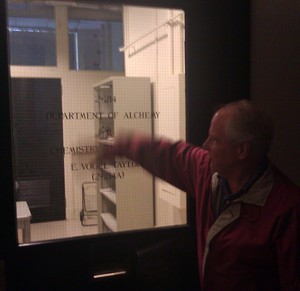 As my very crummy photo shows, Dave Lebling joined us (the People’s Republic of Interactive Fiction) at MIT yesterday for a productive play session of his game The Lurking Horror. (We got 55 of 100 points, which isn’t bad for three hours, even if some of us who’d solved the game did nudge the others along now and then.) Afterwards, we went on a tour of MIT, checking out some of the locations that inspired those in Lebling’s game.
As my very crummy photo shows, Dave Lebling joined us (the People’s Republic of Interactive Fiction) at MIT yesterday for a productive play session of his game The Lurking Horror. (We got 55 of 100 points, which isn’t bad for three hours, even if some of us who’d solved the game did nudge the others along now and then.) Afterwards, we went on a tour of MIT, checking out some of the locations that inspired those in Lebling’s game.
In other great interactive fiction news, a Kickstarter project by Andrew Plotkin, a.k.a. Zarf, was fully funded almost before one could type “transcript on.” Zarf has promised to write Hadean Lands, an IF game for the iPhone, and to work on other IF-related projects. You can still donate money to support Zarf’s work.
Horror Lurks on Halloween
A special event: The People’s Republic of Interactive Fiction is hosting a session in which we’ll play The Lurking Horror, October 31, 2-5pm, MIT’s room 4-145. We’ll take a tour of some MIT campus locations that inspired the ones in this game, and David Lebling, the Infocom implementor who created the game, will be joining us.
Also, remember that there’s a Tuesday Nov 2 book party for the release of my Riddle & Bind, at Grafton St. in Harvard Square, 6-9pm. And on Sunday Nov 7 we’ll have a codefest where people can work on games in Curveship, or on the core system, if they like. Contact me (the login name is “nickm”, the domain to use is this one) if you’d like to join us for that event.
Riddle & Bind is out. Party!
 My book Riddle & Bind (with an official publication date of October 31) is out. One day Amazon will have an image of the cover. But for now, anyone can order it through Spineless Books or Amazon, and … there’s a book release party here in Cambridge, in Harvard Square:
My book Riddle & Bind (with an official publication date of October 31) is out. One day Amazon will have an image of the cover. But for now, anyone can order it through Spineless Books or Amazon, and … there’s a book release party here in Cambridge, in Harvard Square:
Grafton Street Restaurant and Bar
1230 Massachusetts Ave.
Cambridge, MA 02138
Tuesday November 2
6-9pm
You’re invited to stop by, peruse the book, and hang out with us. The book will be available for sale, too, but if you just want to come by and flip through it, or try to crack the code of Christian Bök’s encrypted back-cover blurb, that’s fine too. Grafton Street serves fine food and drink, and you’re welcome to purchase yourself some of it – there are no retail obligations, though. I’ll hope to see you there.
Curveship Codefest Coming Up
Anyone who is in the Boston area and interested in spending a day (or a good chunk thereof) helping me push Curveship toward release should shoot me an email. Thanks to a great suggestion from Prof. Fox Harrell, I’ll be hosting a one-day Curveship Codefest soon in MIT’s building 14. People are welcome to write games, to write spin (ways of narrating), and to hack on the core Curveship system with me. We’ll be working toward a release of Curveship under a free software license in December or January.


